#vulturine fish-eagle
Text
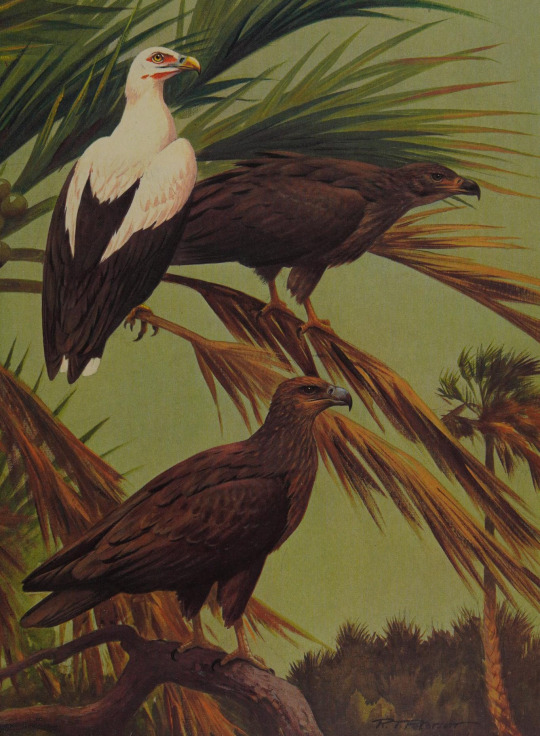
Eagles, Hawks and Falcons of the World. Volume 1. Illustration by Roger Tory Peterson (1908-1996)
192 notes
·
View notes
Text

The Angolan Vulture (Gypohierax angolensis) | Joseph Wolf | Zoological sketches v.1 (1861) | Biodiversity Heritage Library | Flickr | Public domain
2 notes
·
View notes
Text

Two vultures with unusual diets—a bone-eating vulture vs a fruit-loving omnivore!
Bearded vultures seem to have achieved Tumblr fame, and just how much fame that is will be put to the test in this bracket! These vultures have a wide but sparse distribution across Eurasia, occurring in Spain, Morocco, East and Southern Africa, and Western and Central Asia. They greatly prefer mountainous regions. They weigh 4.5–7.8 kg (9.9–17.2 lb) and have wingspans of of 2.31–2.83 m (7 ft 7 in – 9 ft 3 in). Their plumage appears red or orange, but is actually naturally white. They achieve these bright colors by preening colorful dirt into their feathers, and the color is theorized to be a status symbol. Females, which are larger and more dominant, are more brightly dyed. Bearded vultures’ diets are up to 90% bone; it is mostly chicks that eat skin and meat. Adults can crack bones up to the size of a lamb’s femur with their powerful beaks, and break larger ones by dropping them on rocks. They are considered Near Threatened overall but are heavily endangered in Europe due to habitat loss, collisions with power lines, poisoning, and hunting.
Exceedingly unusual among vultures, palm-nut vultures eat primarily fruit—specifically, those of the oil palm and Raffia palm! The rest of their diet is made up of small animals, invertebrates, and sometimes carrion. They live in the forests and savannah of sub-Saharan Africa. They are the smallest Old World vultures, weighing 1.3–1.7 kg (2.9–3.7 lb) and having wingspans averaging 1.5 m (59 in). Also called vulturine fish eagles, they have an eagle-like flight pattern and do not rely on thermals as much as other vultures.
44 notes
·
View notes
Photo

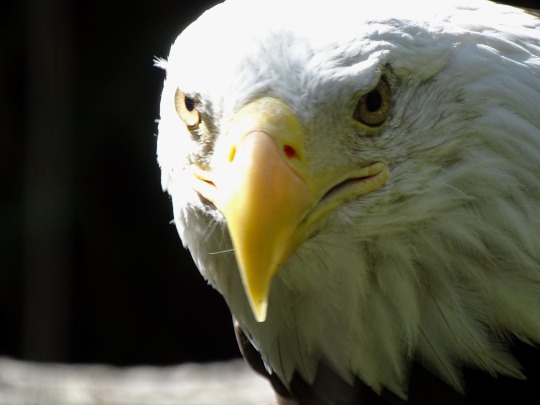
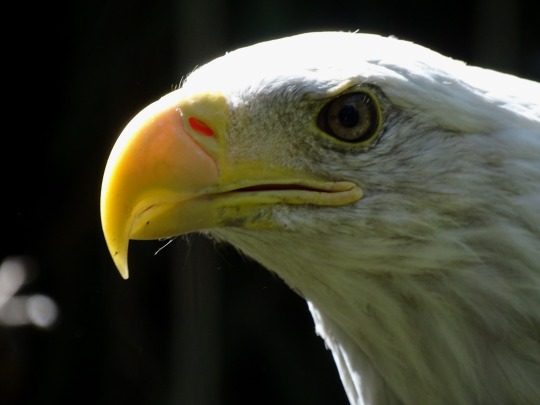



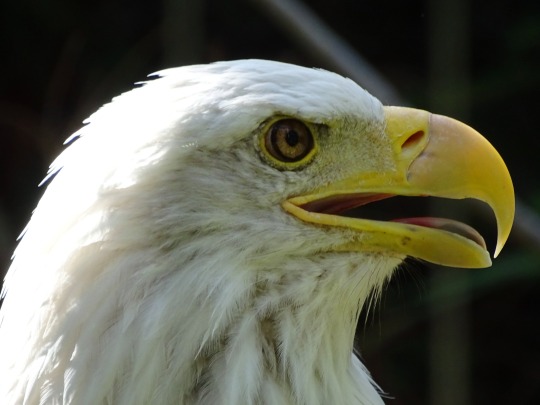



Bald Eagle, Bronx Zoo (No. 2)
The plumage of an adult bald eagle is evenly dark brown with a white head and tail. The tail is moderately long and slightly wedge-shaped. Males and females are identical in plumage coloration, but sexual dimorphism is evident in the species, in that females are 25% larger than males. The beak, feet and irises are bright yellow. The legs are feather-free, and the toes are short and powerful with large talons. The highly developed talon of the hind toe is used to pierce the vital areas of prey while it is held immobile by the front toes. The beak is large and hooked, with a yellow cere. The adult bald eagle is unmistakable in its native range. The closely related African fish eagle (Haliaeetus vocifer) (from far outside the bald eagle’s range) also has a brown body (albeit of somewhat more rufous hue), white head and tail, but differs from the bald in having a white chest and black tip to the bill.
The plumage of the immature is a dark brown overlaid with messy white streaking until the fifth (rarely fourth, very rarely third) year, when it reaches sexual maturity. Immature bald eagles are distinguishable from the golden eagle (Aquila chrysaetos), the only other very large, non-vulturine raptorial bird in North America, in that the former has a larger, more protruding head with a larger beak, straighter edged wings which are held flat (not slightly raised) and with a stiffer wing beat and feathers which do not completely cover the legs. When seen well, the golden eagle is distinctive in plumage with a more solid warm brown color than an immature bald eagle, with a reddish-golden patch to its nape and (in immature birds) a highly contrasting set of white squares on the wing. Another distinguishing feature of the immature bald eagle over the mature bird is its black, yellow-tipped beak; the mature eagle has a fully yellow beak. The bald eagle has sometimes been considered the largest true raptor (accipitrid) in North America. The only larger species of raptor-like bird is the California condor (Gymnogyps californianus), a New World vulture which today is not generally considered a taxonomic ally of true accipitrids. However, the golden eagle, averaging 4.18 kg (9.2 lb) and 63 cm (25 in) in wing chord length in its American race (Aquila chrysaetos canadensis), is merely 455 g (1.003 lb) lighter in mean body mass and exceeds the bald eagle in mean wing chord length by around 3 cm (1.2 in). Additionally, the bald eagle’s close cousins, the relatively longer-winged but shorter-tailed white-tailed eagle and the overall larger Steller’s sea eagle (Haliaeetus pelagicus), may, rarely, wander to coastal Alaska from Asia.
The bald eagle has a body length of 70–102 cm (28–40 in). Typical wingspan is between 1.8 and 2.3 m (5 ft 11 in and 7 ft 7 in) and mass is normally between 3 and 6.3 kg (6.6 and 13.9 lb). Females are about 25% larger than males, averaging as much as 5.6 kg (12 lb), and against the males’ average weight of 4.1 kg (9.0 lb).
The size of the bird varies by location and generally corresponds with Bergmann’s rule, since the species increases in size further away from the Equator and the tropics. For example, eagles from South Carolina average 3.27 kg (7.2 lb) in mass and 1.88 m (6 ft 2 in) in wingspan, smaller than their northern counterparts. One field guide in Florida listed similarly small sizes for bald eagles there, at about 4.13 kg (9.1 lb). Of intermediate size, 117 migrant bald eagles in Glacier National Park were found to average 4.22 kg (9.3 lb) but this was mostly (possibly post-dispersal) juvenile eagles, with 6 adults here averaging 4.3 kg (9.5 lb). Wintering eagles in Arizona (winter weights are usually the highest through the year since like many raptors they spend the highest percentage of time foraging during winter) were found to average 4.74 kg (10.4 lb). The largest eagles are from Alaska, where large females may weigh more than 7 kg (15 lb) and span 2.44 m (8 ft 0 in) across the wings. A survey of adult weights in Alaska showed that females there weighed on average 5.35 kg (11.8 lb), respectively, and males weighed 4.23 kg (9.3 lb) against immatures which averaged 5.09 kg (11.2 lb) and 4.05 kg (8.9 lb) in the two sexes. An Alaskan adult female eagle that was considered outsized weighed some 7.4 kg (16 lb). R.S. Palmer listed a record from 1876 in Wyoming County, New York of an enormous adult bald eagle that was shot and reportedly scaled 8.2 kg (18 lb). Among standard linear measurements, the wing chord is 51.5–69 cm (20.3–27.2 in), the tail is 23–37 cm (9.1–14.6 in) long, and the tarsus is 8 to 11 cm (3.1 to 4.3 in). The culmen reportedly ranges from 3 to 7.5 cm (1.2 to 3.0 in), while the measurement from the gape to the tip of the bill is 7–9 cm (2.8–3.5 in). The bill size is unusually variable as Alaskan eagles could be up to twice the bill length of “southern birds” (i.e. from Georgia, Louisiana, Florida), with means in between the sexes of 6.83 cm (2.69 in) and 4.12 cm (1.62 in) in culmen length, respectively, from these two areas.
Source: Wikipedia
#Birds of Prey#Bronx Zoo#my favorite zoo#animal#bird#close up#beak#head#feather#original photography#travel#vacation#summer 2019#USA#New York City#Eastern USA#flora#fauna#nature#tourist attraction#landmark#outdoors#the Bronx#detail#Haliaeetus leucocephalus#Bald Eagle
2 notes
·
View notes
Photo

The palm-nut vulture (Gypohierax angolensis) or vulturine fish eagle, breeds in forest and savannah across sub-Saharan Africa. #birds #birding #birdart #artmagenta #ulf #procreate https://www.instagram.com/p/CLemAPdATlK/?igshid=gkr92nb6ppiz
0 notes
Text
Explore the Amazing Tarangire National Park Safaris with Your families

There’s more to Tarangire National Park Safaris than meets the eye
If you are searching for a safari destination for your next vacation, then Tanzania will give you an experience of a lifetime. Offering so many different national parks for you to explore, Tarangire National Park safaris would top the list. Although it is overlooked most of the time when compared to neighbouring parks of the Northern circuit of Tanzania, the wildlife-filled Tarangire National Park can make your time worthwhile.
Yes, there’s more to Tarangire National Park safaris than meets the eye! The park is blessed with a fantastic ecosystem that helps a wide variety of animals to live freely and roam wild in their beautiful natural habitat. The indiginous vegetation of this park is covered with a mixture of lush, green grass, hills, and plenty of trees that play a significant role in making this sanctuary the best place for wildlife viewing. While the park is accessible all year round, the best season to travel and explore Tarangire National Park Safaris is during the dry season (June through to October).
Discover safari animals of Tarangire National Park
Without a doubt, when you get a chance to discover Tarangire National Park Safaris and activities, you will be in awe of all that it has to offer from sunrise to sunset. From the open spaces to strewn with baobab and acacia trees, there is a lot to discover including the Maasai Steppe and the southern mountains that make the scenic view of this park outstanding and excellent.
With a population of more than 1,600 elephants, Tarangire National Park is one of the best places in Africa to see vast herds of elephants walking in lines with the babies! Being so close to Lake Manyara National Park, there is a short annual migration of wildebeest and zebra that happens between these two beautiful parks. You can see astounding creatures that roam the park such as waterbuck, giraffe, zebra, warthog, wildebeest, oryx, and buffalo as well as some amazing predators such as the legendary African lion, leopard, and crocodile.
Are you a bird lover? Tarangire National Park is a haven for all bird enthusiasts! While on your safari, you can discover some rare and fascinating species of birds including the fish eagle, grey heron, Masai, and Somali ostrich, lesser and greater flamingo, lappet-faced vulture, and vulturine guineafowl, just to mention a few. To say the least, if you are lucky enough to visit Tarangire National Park on safari, you will enjoy a-one-of-a-kind game viewing experience!
The best places to stay in Tarangire National Park
Similar to many other national parks in Tanzania, Tarangire National Park offers a unique setting for safari-goers to stay inside the park provided that the guests have booked with a reputable tour operator. With several options to choose from, spending a night or two at the park will enhance your safari experience and maximize your wildlife viewing. However, you must hire a professional and experienced local tour operator who will ensure your safari package at Tarangire is safe, hassle-free, and cost-effective. The tour operator will arrange everything for you, in advance, and according to your specific travel style, budget and expectation. In most cases, you will be provided with a private guide and private vehicle that will offer you unlimited game drives and exploration. You will stay in some of the most unique safari camps and lodges in which you will be able to unwind and enjoy some delicious food and sundowners.
Ready to start planning your Tarangire National Park safaris? Wito Africa Safaris is one of the best professional tour operators who can plan your unforgettable safari experience to Tanzania from your arrival to your departure. Their team will help you create a personalized journey based on your specific needs, travel style, and budget. To create or book your safari experience, you can visit www.witoafricasafaris.com or call +1.315.805.4040 for more information!
0 notes
Photo
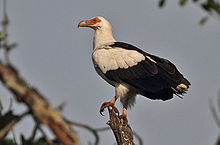

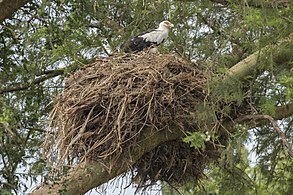

102) Palmojad, rakama, palm-nut vulture, vulturine fish eagle (Gypohierax angolensis) – gatunek padlinożernego ptaka z rodziny jastrzębiowatych (Accipitridae), jedyny przedstawiciel rodzaju Gypohierax. Występuje na terenie Afryki subsaharyjskiej. Wyglądem przypomina bielika, długość ciała 57–65 cm, masa ciała 1200–1800 g (średnio 1470 g), rozpiętość skrzydeł 135–155 cm. Jego głowa jest nieopierzona wyłącznie wokół oczu. Głowa i tułów pokryte są białymi piórami, ogon i skrzydła są czarno-białe, dziób żółtawy, u nasady szaroniebieski. Gatunek po raz pierwszy naukowo opisał w 1788 roku niemiecki zoolog Johann Friedrich Gmelin nadając mu nazwę Falco angolensis. Holotyp na podstawie tekstu „Angola Vulture” Johna Lathama pochodził z Angoli. Etymologia: - Gypohierax (Gyphierax): gr. γυψ gups, γυπος gupos „sęp”; ἱεραξ hierax, ἱερακος hierakos „jastrząb, sokół” - Racama (Recama): według Bruce’a (1790) Rachamah była nazwą ścierwnika (Neophron percnopterus) w Egipcie i Afryce Północnej; Goodman (1986) sugeruje, że Rakhama jest ogólnym określeniem dla sępów Egipcie - angolensis: Angola (port. Angola, od słowa Ngola będącego tytułem władców Ndongo).
1 note
·
View note
Text
Birding in Kenya

Kenya is best known as a safari destination for viewing big mammals, However, birding is also spectacular activity to explore.
Kenya has a unique and diverse array of habitat types, ranging from the snow-capped mountains at about 5000 meters above sea level, tropical lowlands, highland forests, vast savannas, and rolling plains and grasslands to the coastal dry forests and the shores of the Indian Ocean.
With 1100 bird species, including more than 20 endemics and near-endemics, and lots of easy open-country birding and big game, Kenya is simply a must-do birding destination. it's possible to see over 600 species on a single tour dependent on the number of days. The varied geography of Kenya is the reason for such species diversity, and a basic knowledge of its geography is helpful in understanding the birding opportunities.
Throughout Kenya you will experience some fantastic birding and excellent large game viewing, so there will always be something to draw the eye. You get a chance to walk in the forests and drive among the many large game animals that the plains of east Africa are famous for.
Unsurpassed in its combined wealth of bird life and mammal spectacle; includes Mt. Kenya, the arid north, Rift Valley lakes, Kakamega Forest and the far west, Masai Mara, Tsavo and the Taita Hills, and the coast.
There is a big list of available birds to glimpse, the most obvious are birds of the open savanna such as Common Ostrich, bustards, and Secretary-bird and the astounding concentrations of flamingos on soda lakes, especially Lake Nakuru. Less obvious are the lucky chances to photograph Bateleur, African Fish-Eagle, and the many other raptors of open country. The gaudy displays of whydahs and widowbirds during mating season offer spectacular photo opportunities. Many bird species such as fiscals and weavers of open country are readily photographed. With patience it's also possible to photograph birds of the Kakamega Forest and other forested habitats. It's actually quite surprising how many opportunities arise to photograph birds in addition to mammals while on safari.
See also Hartlaub's Turacos and flocks of Red-fronted Parrots from a lodge rooftop set within montane forest--while sunlight dances on snow-capped Mount Kenya beyond. Or to slowly work the tracks in arid Samburuland, watching for Vulturine Guineafowl, Martial Eagle, coursers, sandgrouse, bee-eaters, and bushshrikes. To look out at dawn over Lake Nakuru, speckled with nearly a million flamingos, or to view a Bristle-crowned Starling or Hemprich's Hornbill at the base of the lofty cliffs of the Great Rift Valley. From tiny wattle-eyes and fanciful sunbirds in the rainforest at Kakamega to Secretary-birds foraging among the ungulates on the open plains of Masai Mara--with Lions or Cheetah never far away. We also include a visit to the Taita Hills for the rare endemic Taita Thrush, and to the coast where a whole array of barbets, woodpeckers, thrushes, flycatchers, batises, helmet-shrikes, and sunbirds await you. Coastal forests at Arabuko-Sokoke (with Sokoke Scops Owl and Fischer's Turaco), highland grasslands at Aberdares and Kinangop (with Aberdare Cisticolaand Sharpe's Longclaw), highland forests at Taita Hills, Aberdares, Gatamaiyu and Mt Kenya (with Taita Apalis, Abbot's Starling and Hartlaub's Turaco), tropical forest at Kakamega (with Turner's Eremomela and Blue-headed Bee-eater), deserts at Marsabit (with Masked Lark, William's Lark and Heuglin's Bustard) and savannas at Tsavo East and Tsavo West, Lake Baringo, Buffalo Springs and Masaai Mara (with a whole host of species).
East Africa is one of the wonders of the world. Not only are the diversity and abundance of large mammals legendary, but the birding in this region is one of the world’s richest.
Top Weekend Getaway Deals in Kenya
If you think you have to travel far to enjoy a nice weekend, you may never get away. Besides, you can enjoy a beautiful weekend right here in Kenya. There are countless wallet-friendly Kenyan weekend getaways that won’t even break your budget. Don’t spend your weekend, doing absolutely nothing at home. Whether you are looking for romantic destinations, pristine beaches, and adventurous outdoor activities, there are plenty wallet-friendly getaways that will satisfy your weekend desires.
Mombasa South Coast Self Drive Deals
Lake Nakuru & Elementaita Self Drive Deals
Lukenya & Machakos Self Drive
Amboseli and Tsavo Holiday Self Drive Deals
Mt. Kenya & Aberdare Self Drive Holiday Deals
Mombasa North Coast Self Drive Deals
Samburu Holiday Self Drive Deals
Masai Mara Self Drive Holiday Packages
Malindi & Watamu Self Drive Deals
Nyahururu & Laikipia Holiday Self Drive Deals
Top Madaraka Express SGR Holiday Deals
2 Nights Malindi & Watamu holiday with SGR
2 Nights Amboseli Holiday With SGR
2 Nights Tsavo Holiday With SGR Sa
2 Nights Voi Holiday With SGR
2 Nights Mombasa North Coast With SGR
2 Nights Mombasa South Coast With SGR
Read the full article
#magicalKenya#makeitkenya#tembeakenya#whyIloveKenya#adventuretravel#africansafaris#birdingKenya#Kenyasafari#Kenyavacation#toptraveldestinations#travel#Traveltravel
0 notes
Text
Birding in Kenya
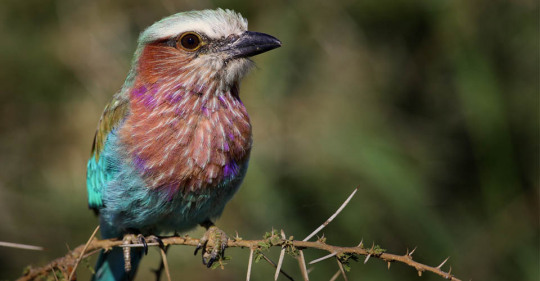
Kenya is best known as a safari destination for viewing big mammals, However, birding is also spectacular activity to explore.
Kenya has a unique and diverse array of habitat types, ranging from the snow-capped mountains at about 5000 meters above sea level, tropical lowlands, highland forests, vast savannas, and rolling plains and grasslands to the coastal dry forests and the shores of the Indian Ocean.
With 1100 bird species, including more than 20 endemics and near-endemics, and lots of easy open-country birding and big game, Kenya is simply a must-do birding destination. it's possible to see over 600 species on a single tour dependent on the number of days. The varied geography of Kenya is the reason for such species diversity, and a basic knowledge of its geography is helpful in understanding the birding opportunities.
Throughout Kenya you will experience some fantastic birding and excellent large game viewing, so there will always be something to draw the eye. You get a chance to walk in the forests and drive among the many large game animals that the plains of east Africa are famous for.
Unsurpassed in its combined wealth of bird life and mammal spectacle; includes Mt. Kenya, the arid north, Rift Valley lakes, Kakamega Forest and the far west, Masai Mara, Tsavo and the Taita Hills, and the coast.
There is a big list of available birds to glimpse, the most obvious are birds of the open savanna such as Common Ostrich, bustards, and Secretary-bird and the astounding concentrations of flamingos on soda lakes, especially Lake Nakuru. Less obvious are the lucky chances to photograph Bateleur, African Fish-Eagle, and the many other raptors of open country. The gaudy displays of whydahs and widowbirds during mating season offer spectacular photo opportunities. Many bird species such as fiscals and weavers of open country are readily photographed. With patience it's also possible to photograph birds of the Kakamega Forest and other forested habitats. It's actually quite surprising how many opportunities arise to photograph birds in addition to mammals while on safari.
See also Hartlaub's Turacos and flocks of Red-fronted Parrots from a lodge rooftop set within montane forest--while sunlight dances on snow-capped Mount Kenya beyond. Or to slowly work the tracks in arid Samburuland, watching for Vulturine Guineafowl, Martial Eagle, coursers, sandgrouse, bee-eaters, and bushshrikes. To look out at dawn over Lake Nakuru, speckled with nearly a million flamingos, or to view a Bristle-crowned Starling or Hemprich's Hornbill at the base of the lofty cliffs of the Great Rift Valley. From tiny wattle-eyes and fanciful sunbirds in the rainforest at Kakamega to Secretary-birds foraging among the ungulates on the open plains of Masai Mara--with Lions or Cheetah never far away. We also include a visit to the Taita Hills for the rare endemic Taita Thrush, and to the coast where a whole array of barbets, woodpeckers, thrushes, flycatchers, batises, helmet-shrikes, and sunbirds await you. Coastal forests at Arabuko-Sokoke (with Sokoke Scops Owl and Fischer's Turaco), highland grasslands at Aberdares and Kinangop (with Aberdare Cisticolaand Sharpe's Longclaw), highland forests at Taita Hills, Aberdares, Gatamaiyu and Mt Kenya (with Taita Apalis, Abbot's Starling and Hartlaub's Turaco), tropical forest at Kakamega (with Turner's Eremomela and Blue-headed Bee-eater), deserts at Marsabit (with Masked Lark, William's Lark and Heuglin's Bustard) and savannas at Tsavo East and Tsavo West, Lake Baringo, Buffalo Springs and Masaai Mara (with a whole host of species).
East Africa is one of the wonders of the world. Not only are the diversity and abundance of large mammals legendary, but the birding in this region is one of the world’s richest.
Read the full article
#magicalKenya#makeitkenya#tembeakenya#whyIloveKenya#adventuretravel#africansafaris#birdingKenya#Kenyasafari#Kenyavacation#toptraveldestinations#travel#Traveltravel
0 notes
Text

Let’s give a round of applause for the lovely contestants of our first matchup!
Hooded vultures are smallish vultures that live in sub-Saharan Africa. These cuties eat mostly carrion but also insects. Their “hood” gives them the appearance of a scrawny balding man. They may live in flocks of 50-250 birds or alone, and they often live in close proximity to human habitation, where they are colloquially known as “garbage collectors.” Their wingspans span from 1.55–1.8 m (61–71 in) and weight from 1.5–2.6 kg (3.3–5.7 lb). Unfortunately, they are critically endangered due to poisoning, hunting, habitat loss, and collisions with power lines.
Exceedingly unusual among vultures, palm-nut vultures eat primarily fruit—specifically, those of the oil palm and Raffia palm! The rest of their diet is made up of small animals, invertebrates, and sometimes carrion. They live in the forests and savannah of sub-Saharan Africa. They are the smallest Old World vultures, weighing 1.3–1.7 kg (2.9–3.7 lb) and having wingspans averaging 1.5 m (59 in). Also called vulturine fish eagles, they have an eagle-like flight pattern and do not rely on thermals as much as other vultures.
23 notes
·
View notes